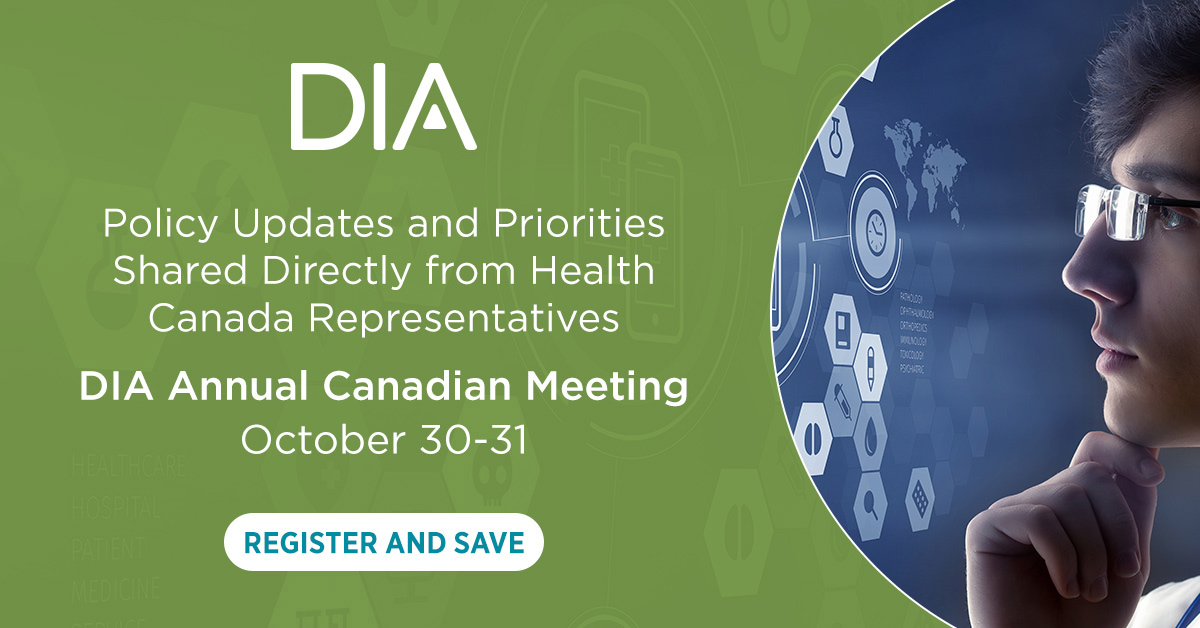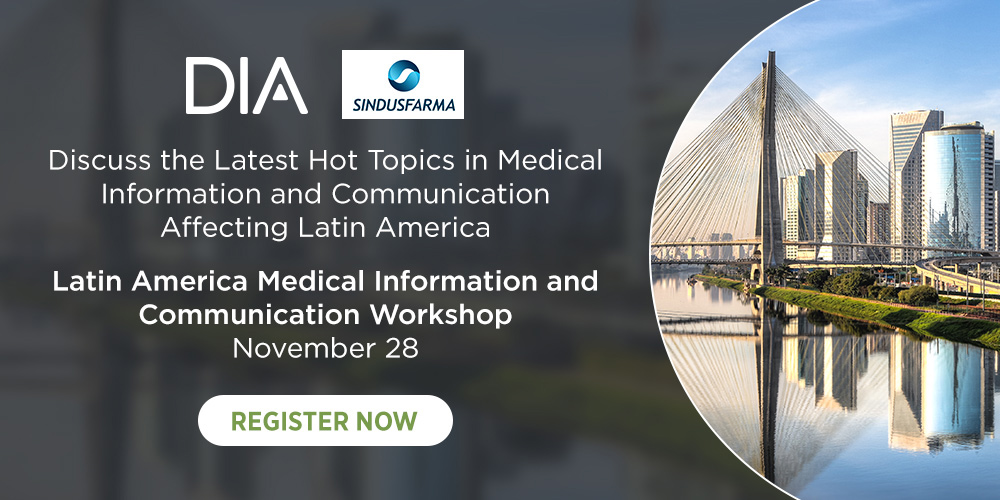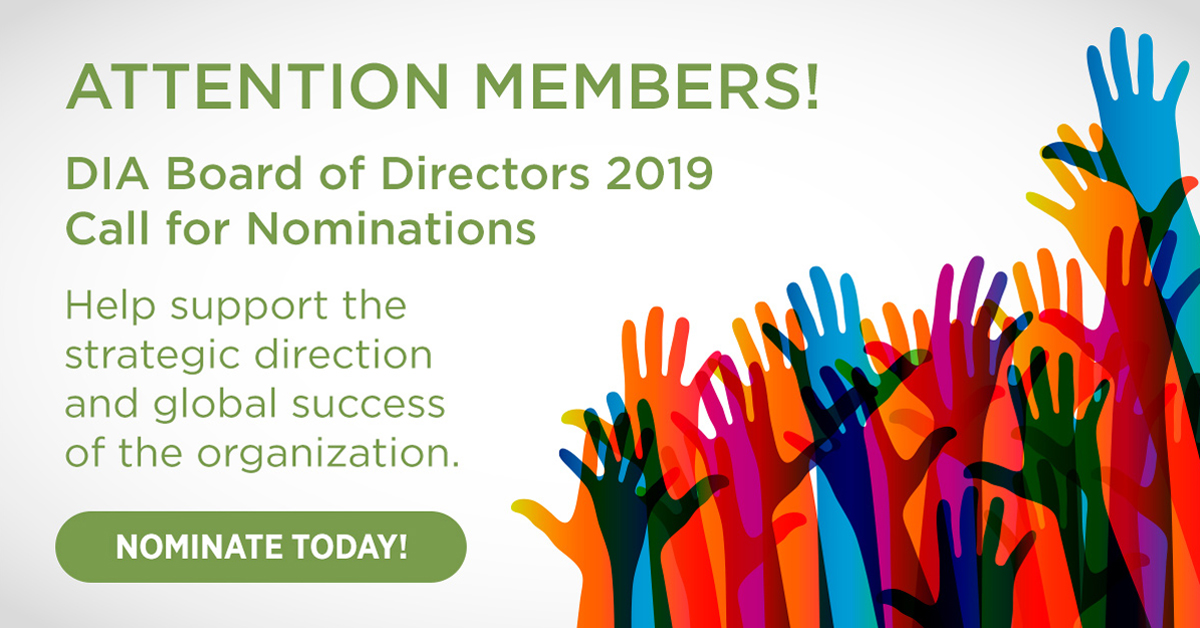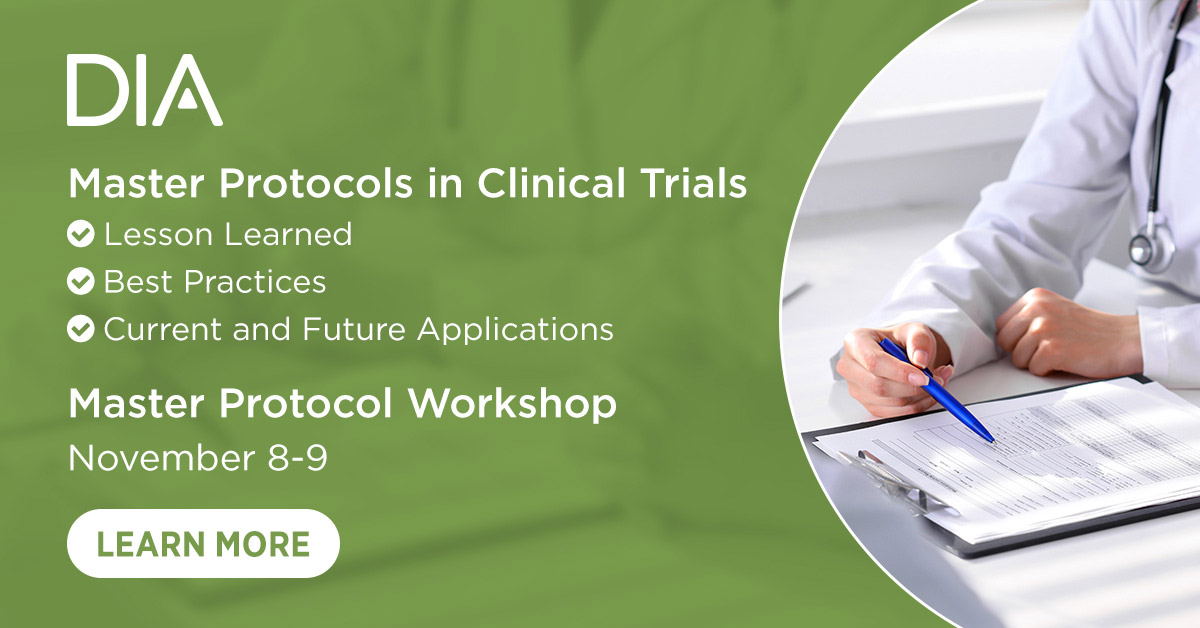October 2018 Global Forum
Table of Contents
AROUND THE GLOBE
AROUND THE GLOBE CONTINUED
CAREER COLUMN
WHITE PAPER
EXECUTIVE LEADERSHIP
Subscribe
Love Global Forum‘s new online format? Subscribe today and never miss an issue.
Editorial Board
Content stream editors
Translational science
Gary Kelloff US National Institutes of Health
David Parkinson ESSA Pharma, Inc.
regulatory science
Yoshiaki Uyama Pharmaceuticals and Medical Devices Agency (PMDA)
Adora Ndu BioMarin Pharmaceutical, Inc.
Patient engagement
Deborah Collyar Patient Advocates In Research (PAIR)
Lode Dewulf Servier
Value & access
Edith Frénoy European Federation of Pharmaceutical Industries and Associations (EFPIA)
Sean Tunis Center for Medical Technology Policy (CMTP)
Editorial Staff
Alberto Grignolo, Editor PAREXEL International
Ranjini Prithviraj, Senior Managing Editor, Associate Director DIA Publications
Sandra Blumenrath, Science Writer DIA Publications
Chris M. Slawecki, Senior Digital Copyeditor DIA Publications
Regional Editors
AFRICA
David Mukanga Bill and Melinda Gates Foundation
ASEAN
Silke Vogel Duke-National University of Singapore Graduate Medical School
AUSTRALIA/NEW ZEALAND
Richard Day University of New South Wales, Medicine, St Vincent’s Hospital
CANADA
Judith Glennie JL Glennie Consulting, Inc.
Megan Bettle Health Canada
CENTRAL AND SOUTH AMERICA
Jaime Oliveira Bayer S/A
CHINA
Ling Su Shenyang Pharmaceutical University, Lilly Asia Ventures
EUROPE
John Lisman Lisman Legal Life Sciences
INDIA
J. Vijay Venkatraman Oviya MedSafe
JAPAN
Junichi Nishino Novartis
US
Ann Meeker-O’Connell IQVIA
DIA Membership
Bringing together stakeholders for the betterment of global health care.
How ICH Really Works: Insights from An Insider
Toshiyoshi Tominaga
he recent reform of the International Council for Harmonisation of Technical Requirements for Pharmaceuticals for Human Use (ICH) with regard to membership and structure has drawn a great deal of interest. The expansion of participants and the creation of a new decision-making organ (the ICH Assembly) have been closely followed and discussed. But since the principal mission of ICH is to develop harmonized guidelines, which are the essential products of the organization, the nature as well as the impact of these “products” (especially the most recent guidelines) should deserve no less attention than the organization itself.
Molecular Diagnostics with Clinical Utility: Their Promise in Advancing Precision Medicine in Cancer
Howard I. Scher
Memorial Sloan Kettering Cancer Center
Caroline C. Sigman
CCS Associates
Gary J. Kelloff
Head
National Cancer Institute
David R. Parkinson
ESSA Pharma
iomarker development is focused on a context of use represented by the unmet need for a more informed diagnostic or therapeutic decision at a particular point in the course of a disease. Once need is determined, a test is developed and standardized to measure and report the information required.
However, developing tests with rigorously validated clinical utility can be challenging from an evidence generation perspective, as well as in attaining consensus among patients, physicians, researchers, regulators, and third -party payers regarding what defines utility in a specific context. The result is high failure rates, higher costs, and limited deployment of potentially beneficial tests for the patients who need them.
![]() Podcasts
Podcasts
Block Chain, AI, Internet of Things: Future of PharmaTech?
The Next Big Step Toward a Collaborative Clinical Ecosystem
Automating Information Flow Through a Clinical Network
Jim Reilly
Vice President, Clinical Market Strategy
Veeva Systems
he life sciences industry continues to innovate and develop breakthrough cures and treatments at a rapid pace. The US Food and Drug Administration (FDA) approved 46 novel drugs last year—more than double the previous year—and 2018 is expected to see a record number of new drugs introduced.
![]() Podcasts
Podcasts
Value-Based Assessment & Contracting: What Needs to Be Done?
![]() Podcasts
Podcasts
Advancing the Science of Study Endpoints
White Paper
Next Generation Technology is Driving Life Sciences Innovation in R&D
Around The Globe
Down Under, Changes at the Top
Perspective on the Fast-Tracking of Drug Approvals
Richard Day
Professor of Clinical Pharmacology
University of New South Wales
St. Vincent’s Hospital
ustralia has got into the habit of discarding Prime Ministers with excessive enthusiasm over the past eleven years, with Mr. Scott Morrison being the seventh to lead the country during this period. The Health Minister responsible for the TGA, Greg Hunt, returns to this position which suggests that medicines policy might remain fairly “static,” but significant changes in the pharmaceutical industry have occurred.
Released this past May, the National Medical Technology, Biotechnology and Pharmaceutical growth plan (MTP), part of the National Health and Medical Industry plan, profiles the sector and its outlook to 2030. Highlighted was the economic growth potential, with this industry now accounting for seven percent of the economy, 14 percent of the workforce, and 20 percent of the Commonwealth’s financial outlays. Forecasts include a fourfold increase in the drug, device, and therapeutic industries; 200 more MTP companies; 28,000 new highly skilled MTP jobs, half of which will be associated with research; and the country becoming a global market leader in clinical trial provision.
Around The Globe
New Development of Rare Disease Policy in China
ince the passage of the Orphan Drug Act by the US Congress in 1983, many other countries have followed suit in later years to develop their own orphan drug legislation or regulation. In China, although there have been some sporadic guidelines and opinions on the subject from various agencies since 2007, an official definition of a rare disease or a clear regulatory pathway for rare disease products was not available until recently.
Disclaimer: The thoughts and opinions expressed in this article belong solely to the authors and do not reflect the views of the authors’ employer or any other organization, group, or individual the authors are affiliated with. The article includes unofficial policy explanations and projections that may not be correct. Any action you take upon the information provided in this article is strictly at your own risk.
![]() Videos
Videos
Deepening Regulatory Reform in China
Around The Globe
Autonomy or Reliance? The East African Community Seeks Both
Hon. Christoph Bazivamo
Deputy Secretary General,
Social and Productive Sectors,
EAC Secretariat
Stanley Sonoiya
Principal Health Officer,
EAC Secretariat
David Mukanga
Senior Program Officer Global Health,
Bill & Melinda Gates Foundation
hould each East Africa Community (EAC) partner state have an autonomous medicine regulatory agency while the region promotes regulatory harmonization and reliance? Do we need both? Given constrained government budgets, we are often faced with this question. Should countries that do not already have one, establish one? Should those countries that already have one reconsider its place and role?
Why Do Nations Need to Regulate Medicines?
Medicines are not ordinary consumer goods, and therefore consumers may not be able to determine if a medicine is safe, efficacious, and of quality. Safety relates to weighing the known benefits of using the medicine against the known risks. Efficacy refers to the ability of the medicine to produce the desired beneficial effect claimed on the medicine label by the manufacturer, when used as labeled in the intended population.
Quality of a medicine is a manufacturing concept that addresses the consistency of the manufacturing process to ensure that medicines meet international standards in terms of strength, purity, packaging, and labeling. It would be hugely problematic for example, if the same pill you take today were to have a different quantity of the active substance/ingredient (e.g., 10 mg) from the one you take tomorrow (perhaps 18 mg) when both claim to contain 10 mg, or it had a different active ingredient or no active ingredient at all. The concept and means of assuring quality has evolved over time. However, even healthcare professionals (medical doctors, pharmacists) may not have the capacity to make informed decisions about all aspects of medicines without special training and access to information about how the medicine was manufactured.
Around The Globe
Japan’s Role in Promoting Global Clinical Research
The Model of Osaka University Hospital
Daisaku Nakatani
Chisa Tabata
Koji Nishida
Akira Myoui
Tomomi Yamada
Yoichi Yamamoto
Bolrathanak Oeun
Ken Nakata
Junzo Seki
Mayuko Ouchi
Osaka University Hospital
Japan’s Role in Promoting Global Clinical Research
The Model of Osaka University Hospital
Daisaku Nakatani
Chisa Tabata
Koji Nishida
Akira Myoui
Tomomi Yamada
Yoichi Yamamoto
Bolrathanak Oeun
Ken Nakata
Junzo Seki
Mayuko Ouchi
Osaka University Hospital
he number of industry-initiated global clinical trials conducted simultaneously in multiple countries under the same protocol has been increasing annually. This may contribute to avoiding a drug- and device-lag for clinical use across the world. However, we must recognize that the differences in regulations, standards of treatment, and medical insurance systems in different countries, as well as ethnic factors, may lead to challenges for the conduct of clinical trials.
In October 2016, Osaka University Hospital was awarded the Global Clinical Trial Development Project led by the Japan Agency for Medical Research and Development (AMED). In response to this award, the Global Clinical Research Support Group (GCRSG) was launched within the Department of Medical Innovation (DMI). The Group was set up independently of the four existing centers in the DMI in order to receive support from all centers. In April 2018, the GCRSG was moved under DMI’s Center for Global Health (Figure 1). The GCRSG aims to respond to and support a range of activities, including planning and designing multinational clinical research and trials, and regulatory actions and negotiations from the perspective of future global development in collaboration with other clinical research core hospitals, thereby realizing the mission that multinational clinical research and trials initiated by physicians in Japan in particular should play a central role in such global activities.
![]() Podcasts
Podcasts
DIA Japan’s Focus in Fall 2018
Community Spotlight
TrialScope
CTD Community Chair
he Clinical Trials Disclosure (CTD) Community focuses on the global trend to put more and more clinical trial information in the public domain, driven by regulation, transparency advocates, and the general public. Our community has grown to 375 very active members. We host a monthly conference call and annual conferences, and we also enjoy the active involvement from the teams at ClinicalTrials.gov and the European Medicines Agency (EMA).
- Improve global transparency and compliance: Educate new and existing members on the regulations, requirements, trends, and best practices that are driving global clinical trial transparency and improve global compliance.
- Keep current with the requirements: Nurture the Community’s relationships with regulators, transparency advocates, and patient communities to stay current with their expectations.
- Outreach: Clinical trial transparency impacts anyone conducting clinical research and many of them aren’t aware that this Community is a useful resource.
Career Column
The Power of Nonverbal Communication: Saying Everything Without Saying Anything
Ruth H. Nobile
Bayer Pharmaceuticals
Rutgers University
hink back to the last time you were on an airline flight. You probably experienced some turbulence. You probably heard the Captain repeat the same words about the fasten seat belt sign and remaining in your seat that are heard countless times each day in airplanes all over the world. And you probably saw your flight attendants casually sit down to ride out the turbulence with the pages of a good magazine, so relaxed they seemed to wordlessly say, “There’s nothing to worry about here.”
Now imagine this same flight, this same turbulence, and these same words. But this time your flight attendants clutch and hold onto each other and cry. Loudly.
In 1971, Dr. Albert Mehrabian, a professor at UCLA, published a book called Silent Messages. He claimed that 93 percent of what we say to people, we say without words; more specifically, 55 percent of communication is done through body language and 38 percent through tone. Only the remaining seven percent of what we say is said with spoken words.
![]() Podcasts
Podcasts
Disparities Between FDA/EMA Review Processes
Epoietin Biosimilars: Qualitative Study of Patients’ Views
US REMS Requirements for NDAs and BLAs

Thanks for reading our October 2018 Issue!






